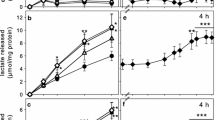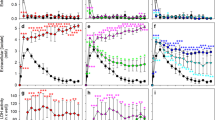Abstract
Brain tissue cells have been shown to use two predominant pathways for energy production. The first of these is the pentose phosphate shunt, and the second is glycolysis, followed by the TCA cycle. Inhibition of these pathways can result in a reduction of ATP, and changes in the concentration of various metabolites. In the present study, the acute and chronic effect of 6-aminonicotinamide (6-AN) (0.01, 0.02, and 0.03 mg/ml) was examined on astrocytes and C6-glioma cells. Following this treatment, glucose, lactate, glutamate, ATP, and PCr were assayed according to the procedures of Lowry and Passonneau. Our data indicated that following 15 minutes treatment of astrocytes and C6-glioma with 6AN there was no significant difference in the concentration of metabolites measured. However, following 24 hours treatment there was a significant increase in glucose concentration and significant reduction in the concentration of ATP, PCr, lactate and glutamate in both cell types. Morphological changes appeared later following 48 hours treatment with 6-AN in both cell types. Glucose accumulation can be explained by the fact that it is the precursor to both glycolysis and the pentose phosphate shunt. If these processes are inhibited, glucose will obviously accumulate and products like ATP, PCr, lactate and glutamate will decrease. Additionally, there was significant differences in concentration of glucose and lactate between astrocytes and C6-glioma cells. The significance of these differences has been discussed.
Similar content being viewed by others
References
Aikawa, H., Suzuki, K., Ito, N., Iwasaki, Y., Nonaka, I. (1984). 6-Aminonicotinamide-induced hydrocephalus in suckling mice.J. Neuropathol. Expl. Neurol. 43(5):511–521.
Biddle, F.G. (1977). 6-aminonicotinamide-induced cleft palate in the mouse: The nature of the difference between the A/J and C57BL/6J strain in frequency of response and its genetic basis.Teratology 16:301–312
Blakemore, W.F. (1975) Remyelination by schwann cells of axons demyelinated by intraspinal injection of 6-aminonicotinamide in the rat.J. Neurocytol. 4:745–757
Buell, M.V., Lowry, O.H., Roberts, N.R., Chang, M.W., and Kapphahn, J.I. (1958). The quantitative histochemistry of the brain. V. Enzymes of glucose metabolism.J. Biol. Chem. 232:979–993
Cavanagh, J.B. (1993) Selective vulnerability in acute energy deprivation syndromes. (Review).Neuropathol. Applied Neurobiol. 19(6):461–470
Chamberlain, J.G. (1970) Early neurovascular abnormalities underlying 6-aminonicotinamide (6-AN) induced congenital hydrocephalus in rats.Teratology 3:377–388
Chamberlain, J.G., (1973) 6-aminonicotinamide (6-AN) induced abnormalities of the developing ependyma and choroid plexus as seen with the scanning electron microscope.Teratology 6:281–286
Chui, E., and Garcia J.H. (1979). Pathogenesis of 6-aminonicotinamide neurotoxicity New structural analysis. In: (H.M. Zimmermann, ed.)Progress in Neuropathology. New York: Grune and Stratton,4: 341–359
Clarke, D.W., Boyd, F.T. Jr., Kappy, M.S., and Raizada, M.K. (1984). Insulin binds to specific receptors and stimulates 2-deoxy-D-glucose uptake in cultured glial cells from rat brain.J. Biol. Chem. 259:11672–11675
Coper, H., Herken, H. (1963). Schadigung des zns durch antimetaboliten des nicotinsaureamids.Dtsch. Med. Wochenschr. 88:2025–2036
DiChiro, G., DeLapaz, R.L., Brooks, R.A., Sokoloff, L., Kornblith, P.L., Smith, B.H., Petronas, N.J., Kufta, C.V., Kessler, R.M., Johnson, J.S., Manning, R.G., and Wolf, A.P. (1982). Glucose utilization of cerebral gliomas measured by (F)fluorodeoxyglucose and positron emission tomography.Neurology 32:1323–1329.
Edmond, J., Ritter, W.J., Wilson, S.G., and Wilson, J.G. (1975). Inhibition of ATP synthesis associated with 6-aminonicotinamide (6-AN) teratogenesis in rat embryos.Teratology 12:233–238.
Edmond, J., Robbins, R.A., Bergstrom, J.D., Cole, R.A., and Vellis, J.de. (1987). Capacity for substrate utilization in oxidative metabolism by neurons, astrocytes, and oligodendrocytes from developing brain in primary cultures.J. Neurosci. Res. 18:551–561.
Galarraga, J., Loreck, D.J., Graham, J.F., DeLapaz, R.L., Smith, B.H., Hallgren, D., and Cummins, C.J. (1986). Glucose metabolism in human gliomas: correspondance ofin situ andin vitro metabolic rates and altered energy metabolism.Metab. Brain Dis. 1:279–291.
Geller, L.M., Cowen, D., and Wolf, A. (1966). Effect of the antimetabolite 6-aminonicotinamide on sound-induced seizures in mice.Exp. Neurol. 14:86–89.
Griffiths, I.R., Kelly, P.A.T., and Grome, J.J. (1981). Glucose utilization in the central nervous system in the acute gliopathy due to 6-aminonicotinamide.Lab Invest. 44:547–52.
Herken, H., Lange, K., and Kolbe, H. (1969). brain disorders included by pharmacological blockade of the pentose shunt.Biochem. Biophys. Res. Commun. 86:83–100.
Herken, H., Keller, K., Kolbe, H., Lange, K., and Schneider H. (1973). Experimetelle Myelopathie-Biochemische Grundlagen iher cellularen Pathogenese. Klin. Wschr.51:644–657
Hertz, L., and Schousboe, A. (1988). Metabolism of glutamate and glutamine in neurons and astrocytes in primary cultures. In (E. Kvamme, ed)Glutamine and Glutamate in Mammals. Boca Raton. CRC Press, pp 40–45
Horita, N., Oyanagi, S., Ishii, T., and Izumiyama, Y. (1978). Ultrastructure of 6-aminonicotinamide (6-AN) induced lesions in the central nervous system. I. Chromatolysis and other lesions in the cervical cord.Acta Neuropathol. (Berl.) 44:111–119
Horita, N., Ishii, T., and Izumiyama, Y. (1980). Ultrastructure of 6-aminonicotinamide (6-AN)-induced lesions in the central nervous system of rats. II. alterations of the nervous susceptibility with aging.Acta Neuropathol. (Berl). 49:19–27
Horita, N., Ishii, T., and Izumiyama, Y. (1981). Ultrastructure of 6-aminonicotinamide (6-AN)-induced lesions in the central nervous system of rats. III. Alterations of the spinal gray matter lesion with aging.Acta Neuropathol (Berl). 53:227–235
Iglesias-Rozas, J.R., Martin, L.F., and Iglesias, R.E. de. (1973). Histochemical changes in the spinal cord after acute poisoning with 6-aminonicotinamide.Acta Neuropathol. (Berl). 25:220–227.
Iglesias-Rozas, J.R., and Iglesias, R.E. de. (1974). Histochemical changes in the spinal cord after exposure to 6-aminonicotinamide.Acta Neuropathol. (Berl). 28:223–232
Johnson, W.J., and McColl, J.D. (1955). 6-aminonicotinamide, a potent nicotinamide antagonist.Science 122:834
Kauffman, F.C., and Johnson, E.C. (1974). Cerebral energy reserves and glycolysis in neural tissue of 6-aminonicotinamide-treated mice.J. Neurobiol. 1:379–392
Kim, S.U., Wenger, B.S. (1973) Neurotoxic effects of 6-aminonicotinamide on cultures of central nervous tissue.Acta Neuropathol. (Berl) 26:259–264.
Kirsch, W.M. (1965) Substrates in glycolysis in intracranial tumors during complete ischemia.Cancer Res. 25:432–439.
Kohler, E., Barrach, H-J., and Neubert, D. (1970). Inhibition of NADP dependent oxidoreductases by the 6-aminonicotinamide analogue of NADP.FEBS Letters 6:225–228.
Krum, J.M., and Rosenstein, J.M. (1993). Effect of astroglial degeneration on the blood-brain-barrier to protein in neonatal rats.Dev. Brain. Res. 74:41–50.
Landauer, W. (1957). Niacin antagonists and chick development.J. Exp. Zool. 136:509–530.
Lange, K.H., Kolbe, K. Keller, H. and Herken, H. (1970). Der Kohlenhydrastoffwechsel des ghirns, blocked des pentose-phosphat-weges durch 6-Aminonicotinamide.Hoppe-Seylers Z. Physiol. Chem. 351:1241–1252.
Lopes-Cardozo, M., Larson, O.M., and Schousboe, A. (1986). Acetoacetate and glucose as lipid precursors and energy substrates in primary cultures of astrocytes and neurons from mouse cerebral cortex.J. Neurochem. 46:773–778.
Lowry, O.H., and Passonneau, J.V. (1972). A flexible system of enzymatic analysis. Academic Press New York, pp. 129–218.
Marzatico, F., Dagani, F., Curti, D., and Benzi, G. (1987). Phenobarbital and 6-aminonicotinamide effect on cerebral enzymatic activities related to energy metabolism in different rat brain areas.Neurochem. Res. 1:12:33–39
Matschke, G.H., and Fagerstone, K.A. (1977). Teratogenic effects of 6-aminonicotinamide in mice.J. Toxicol. Environ. Health 3:735–743.
McCandless, D.W., and Scott, W.J. (1981). The effect of 6-aminonicotinamide on energy metabolism in rat embryo neural tube.Teratology 23:391–395.
Meyer-Konig, E. (1973). Ultrastruktur der glia- und axonshadigung durch 6-aminonicotinamide (6-AN) am sehnerv der ratte.Acta Neuropathol. (Berl). 26:115–126.
Murphy, M.L., Dagg, C.P., and Karnofsky, D.A. (1957). Comparison of teratogenic chemicals in the rat and chick embryos. Pediat.19, 701.
O'Sullivan, B.M., and Blakemore, W.F. (1980). Acute nicotinamide deficiency in the pig induced by 6-aminonicotinamide.Vet. Pathol. 17:748–758.
Pinsky, L., and Fraser, F.C. (1959). Production of skeletal malformations in the offspring of pregnant mice treated with 6-aminonicotinamide.Biol. Neonate 1:106–112.
Pinsky, L., and Fraser, F.C. (1960) Congenital malformations after a two-hour inactivation of nicotinamide in pregnant mice.Brit. Med. J. 2:195.
Ritter, E.J., Scott, W.J., and Wilson, J.G. (1975). Inhibition of ATP synthesis associated with aminonicotinamide teatogenesis in rat embryos. Teratology12:233–238.
Schardein, J.L., Woosley, E.T., Peltzer, M.A., and Kaump, D.H. (1967). Congenital malformations induced by 6-aminonicotinamide in rabbit kits.Exp. Mol. Pathol. 6:335–346.
Schneider, H., and Cervos-Navarro, J. (1974). Acute gliopathy in spinal cord and brain stem induced by 6-aminonicotinamide.Acta Neuropathol. (Berl). 27:1123.
Schneider, H., and Coper, H. (1968). Morphologische befunde am zentralnervensystem der ratte nach vergiftung mit antimetaboliten des nicotinamides und einem chinolinderivat.Arch. Psychiat. Nervenkr. 211:138–154
Schochet, S.S. Jr. (1970). Pathogenesis of 6-aminonicotinamide neurotoxicity.VIth International Congress of Neuropathology Proceedings. Paris: Masson, 89–90.
Schotland, D.L., Cowen, D., Geller, L.M., and Wolf, A. (1965). A histopathological study of the effects of an antimetabolite, 6-aminonicotinamide, on the lumbar spinal cord of the adult rat.J. Neuropathol. Exp. Neurol. 24:97–107
Schousboe, A., Drejer, J., Hertz, L. (1988). Uptake and release of glutamate and glutamine in neurons and astrocyte in primary cultures. In (E. Kvamme, ed)Glutamine and Glutamate in Mammals Boca Raton. CRC Press, pp 21–38
Siegel, S. (1956). Non-parametric statistics for the behavioral scientist. McGraw-Hill, New York.
Smith, P.K., Krohn, R.I., Hermanson, G.T., Mallia, A.K., Gartner, F.H., Provenzano, M.D., Fujimoto, E.K., Goeke, N.M., Olson, B.J., and Klenk, D.C. (1985). Measurement of protein using bicinchoninic acid.Anal. Biochem. 150:76–85.
Sotelo, C. (1967). Cerebellar neuroglia: morphological and histochemical aspects.Prog. Brain Res. 25: 226–250.
Sotelo, C., and Rio, J.P. (1980). Cerebellar malformation obtained in rats by early postnatal treatment with 6-aminonicotinamide. Role of neuron-glia interactions in cerebellar development.Neuroscience 5:1737–1759
Sternberg, S.S., and Philips, F.S. (1958). 6-aminonicotinamide and acute degenerative changes in the central nervous system.Science 127:644–646
Westergaard, N., Sonnewald, U., and Schousboe, A. (1995). Metabolic trafficking between neurons and astrocytes: The glutamate/glutamine cycle revisited.dev. Neurosci. 17:203–211.
Wolf, A., and Cowen, D. (1959). Pathological changes in the central nervous system produced by 6-aminonicotinamide.Bull. N. Y. Acad. Med. 35:814–817
Author information
Authors and Affiliations
Rights and permissions
About this article
Cite this article
Haghighat, N., McCandless, D.W. Effect of 6-aminonicotinamide on metabolism of astrocytes and C6-glioma cells. Metab Brain Dis 12, 29–45 (1997). https://doi.org/10.1007/BF02676352
Received:
Accepted:
Issue Date:
DOI: https://doi.org/10.1007/BF02676352




